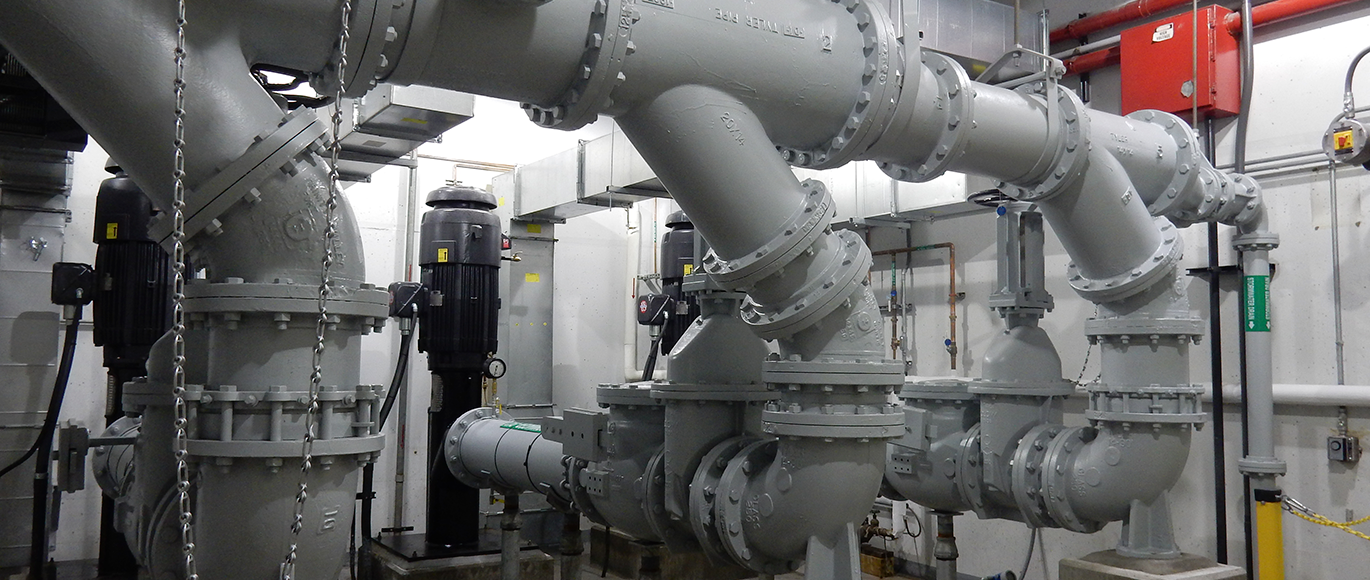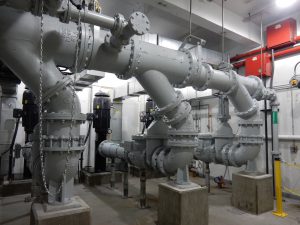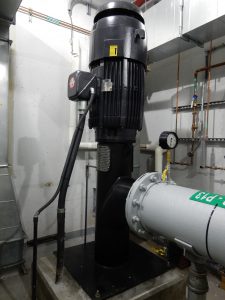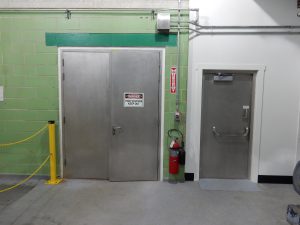
In August of 2020, Hurricane Isaias moved through Philadelphia and dumped four inches of rain on the area in two hours, the recently renovated Pennsylvania Department of Transportation (PennDOT) pump stations for I-95 & I-676 were moving a combined total of 65,000 gallons per minute of stormwater.
 A depressed roadway is a roadway that is set below the level of the surrounding streets. When rainwater falls on a depressed roadway, the rainwater needs to be either be directed to a lower elevation or pumped. When Interstates I-676 and I-95 were constructed through Philadelphia, I-676 was completely depressed through Center City and portions of I-95 were depressed near the Delaware River Waterfront area to avoid intersections with the surface streets. The roadway elevations for these interstate highways are below the level of the Delaware River. All rainwater that falls on these sections of I-95 and I-676 must be collected into storm-water pump stations and pumped to the city’s stormwater sewer system. When these interstate highways were constructed through Philadelphia in the 1980s and 1990s, four stormwater pump stations were included. Around the same time, the intersection of Routes 13 and 413 in Bristol, Bucks County were being reconstructed. As part of that project, a stormwater pump station was installed to eliminate roadway flooding in the area.
A depressed roadway is a roadway that is set below the level of the surrounding streets. When rainwater falls on a depressed roadway, the rainwater needs to be either be directed to a lower elevation or pumped. When Interstates I-676 and I-95 were constructed through Philadelphia, I-676 was completely depressed through Center City and portions of I-95 were depressed near the Delaware River Waterfront area to avoid intersections with the surface streets. The roadway elevations for these interstate highways are below the level of the Delaware River. All rainwater that falls on these sections of I-95 and I-676 must be collected into storm-water pump stations and pumped to the city’s stormwater sewer system. When these interstate highways were constructed through Philadelphia in the 1980s and 1990s, four stormwater pump stations were included. Around the same time, the intersection of Routes 13 and 413 in Bristol, Bucks County were being reconstructed. As part of that project, a stormwater pump station was installed to eliminate roadway flooding in the area.
With these pump stations being close to 40 years old, a study commissioned by PennDOT determined that these five pump stations’ pumping, mechanical, and electrical equipment had reached the end of their useful life and should be renewed. The report found some minor architectural and structural issues as well as new code issues that needed to be addressed. PennDOT also decided to upgrade the tunnel lighting and fire protection dry standpipe system under the covered tunnel portions of I-95 near the Delaware River Waterfront Area of Philadelphia, both of which were beyond their useful lives.
In 2016, PennDOT issued bid documents to rehabilitate the five pump stations under four separate Design-Build contracts. Each contact addressed General, Plumbing, Mechanical, Electrical, and Fire Protection for the five pump stations. Pennoni teamed with PKF-Mark III of Newtown, Bucks County, to submit bids on the four contracts. PKF-Mark III acted as the general contractor and Pennoni provided the design work and acted as the Engineer of Record. PKF-Mark III was successful in winning all four contracts, and notice-to-proceed was issued in 2017 with engineering beginning immediately.
 Each pump station received new high and low flow pumps, electrical service equipment, diesel engine driven standby generators, ventilation, lighting, and controls. Each pump station has different influent flow rates, size pumps, and configurations. In the intervening years since the pump stations were installed 40 years ago, building codes have changed and the design of the stations needed to address these new codes.
Each pump station received new high and low flow pumps, electrical service equipment, diesel engine driven standby generators, ventilation, lighting, and controls. Each pump station has different influent flow rates, size pumps, and configurations. In the intervening years since the pump stations were installed 40 years ago, building codes have changed and the design of the stations needed to address these new codes.
 One of the more challenging codes to meet was the Nation Fire Protection Associations standards (NFPA 820) for stormwater pumping stations. Since there is the potential for flammable liquids, such as gasoline, to enter a stormwater pump station, the pumping station wet wells needed to be segregated from the remaining portions of the pump station. The original electrical equipment and controls were placed in the same area as the pump sumps. To segregate the areas, a partition wall was designed and constructed, forming an electrical room, and separate ventilation systems were installed. To access the electrical rooms, airtight gasketed stainless steel doors, which are commonly used on offshore oil platforms, were used.
One of the more challenging codes to meet was the Nation Fire Protection Associations standards (NFPA 820) for stormwater pumping stations. Since there is the potential for flammable liquids, such as gasoline, to enter a stormwater pump station, the pumping station wet wells needed to be segregated from the remaining portions of the pump station. The original electrical equipment and controls were placed in the same area as the pump sumps. To segregate the areas, a partition wall was designed and constructed, forming an electrical room, and separate ventilation systems were installed. To access the electrical rooms, airtight gasketed stainless steel doors, which are commonly used on offshore oil platforms, were used.
PKF Mark III started construction in 2018. One of their biggest challenges was to maintain at least two of three pumps in service at each pump station, as the pumps were being replaced. They faced similar challenges with installing the new electrical equipment. However, PKF overcame these challenges and worked throughout the COVID-19 shutdown to complete the bulk of the construction on this critical $33.5 million infrastructure project by early Summer of 2020.
Later that same Summer, Hurricane Isaias was no match for the renovated PennDOT pump stations.
 For more information on this project, contact Harry Laspee.
For more information on this project, contact Harry Laspee.
Harry serves as Associate Vice President, and has more than 35 years of experience in the design and contract administration of public works improvement projects including: bridges, highways, water distribution systems, and sanitary and stormwater conveyance systems.